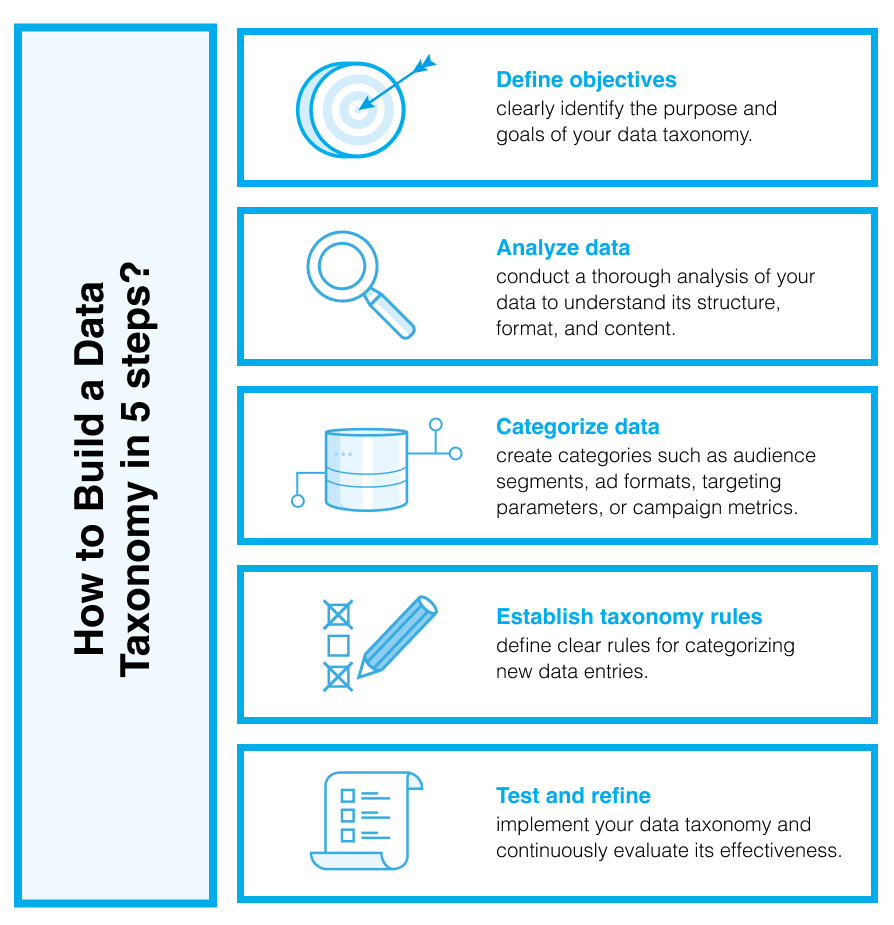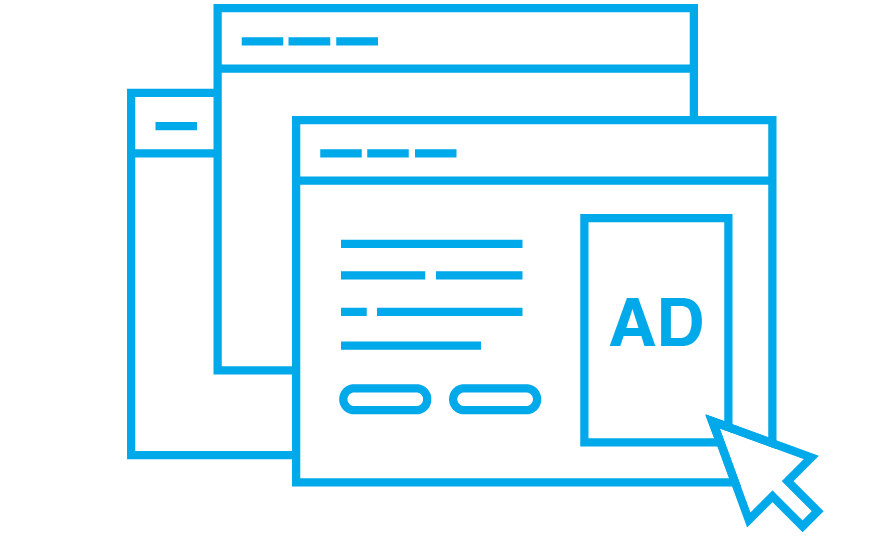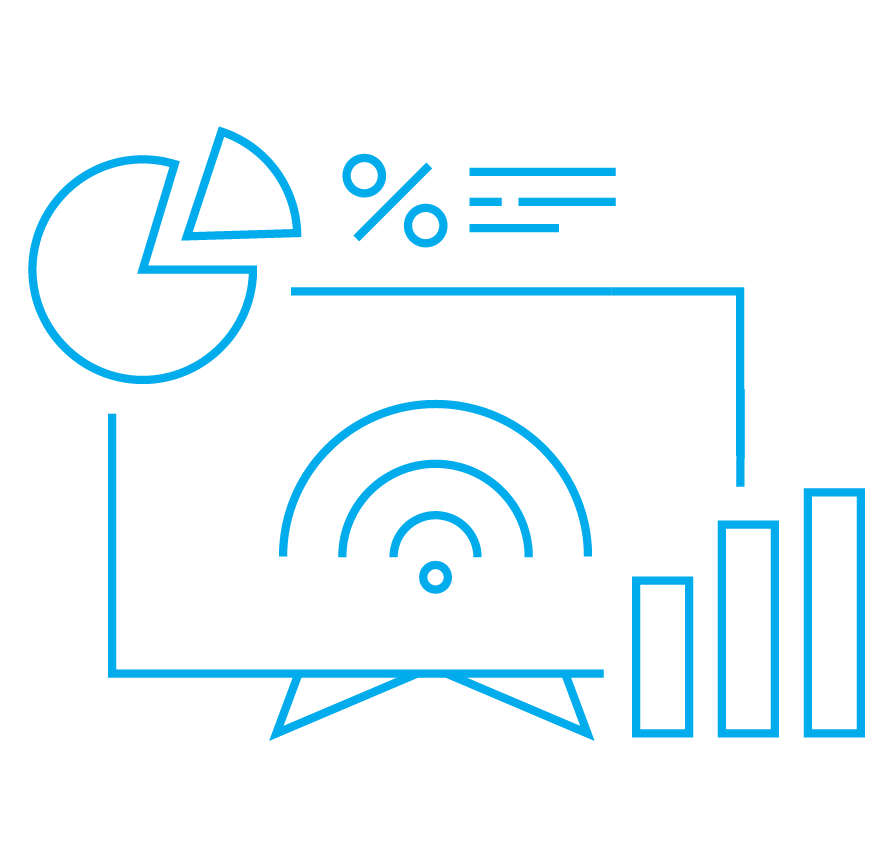- Key Points:
- What Is a Data Taxonomy?
- Why is Data Categorization Crucial in The AdTech Industry?
- What is a Data Taxonomy Example?
- Why Is Data Taxonomy Important in AdTech?
- How Does Data Taxonomy Personalize User Experience?
- How to Build a Data Taxonomy in 5 Steps?
- Wrapping up
Key Points:
- A data taxonomy is a system that classifies and organizes data in a hierarchical manner within an organization.
- A data taxonomy provides a standardized framework for organizing and accessing data, making it easier to search, analyze, and manage information effectively.
- Data categorization in adtech involves the classification and organization of different data elements pertaining to advertising campaigns, audience segments, and customer behavior.
- In the AdTech and MarTech categorizing data aims to align it with business objectives, enabling effective decision-making and optimization of advertising and marketing efforts.
- Data taxonomy is important in AdTech, as it organizes data, enhances targeting and personalization, improves campaign efficiency and provides interoperability.
- Data taxonomies enable segmentation which allow advertisers to categorize users based on their demographics, interests, behaviors and preferences and prepare campaigns aimed at specific target audiences.
- Data categorization is crucial for effective advertising and marketing efforts, as it allows for the targeting of the right audience and optimization of ad creatives based on user behavior.
- Data taxonomies empower retargeting and remarketing, leading to increased user engagement, relevant ads, and desired actions such as conversions and purchases.
- Data taxonomies can be created with the support of data experts and including the following steps: define objectives, analyze data, categorize data, establish taxonomy rules, test and refine.
What Is a Data Taxonomy?
Data taxonomy is a hierarchical classification system used to categorize and organize data within an organization. It involves structuring data into predefined categories or classes based on specific characteristics or attributes.
The purpose of data taxonomy is to provide a standardized framework for organizing and accessing data, making it easier to search, analyze, and manage information effectively. It helps improve data quality, data governance, and overall data management processes within an organization.
Why is Data Categorization Crucial in The AdTech Industry?
In adtech, data categorization helps in classifying and organizing various data points related to advertising campaigns, audience segments, and customer behavior. It enables marketers to efficiently analyze and utilize the collected data for targeted advertising and personalized marketing strategies.
The main goal of categorizing data in adtech and martech is to align the data with the specific needs and objectives of the business, allowing for effective decision-making and optimization of advertising and marketing efforts.
Data categorization plays a crucial role in the AdTech industry as it allows marketers to classify and organize various data points to optimize advertising campaigns and enhance customer targeting. For instance, data can be categorized based on demographic information enabling advertisers to tailor their messages to specific audience segments.
Furthermore, data categorization can be used to group customers based on their browsing behavior or purchase history, allowing marketers to deliver personalized ads and recommended content. By organizing data in this way, businesses can make informed decisions and optimize their advertising and marketing efforts to reach the right audience with the right communication.
What is a Data Taxonomy Example?
To understand the structure and categorization of data, let’s take a look at data taxonomy example concerning automotive industry.

Why Is Data Taxonomy Important in AdTech?
Data taxonomy is important in AdTech for several reasons:
- Organizes and categorizes data: AdTech involves dealing with large volumes of data collected from various sources. A data taxonomy helps organize and categorize this data, making it easier to manage and analyze. It provides a standardized framework for classifying data based on relevant attributes, such as audience segments, content categories, or ad products.
- Enhances targeting and personalization: A well-defined data taxonomy allows advertisers to create audience segments based on specific criteria. These segments can be used for targeted marketing campaigns, ensuring that ads are delivered to the right audience at the right time. Personalized advertising can lead to higher engagement and conversion rates.
- Improves campaign effectiveness: By utilizing a data taxonomy, AdTech professionals can access and utilize relevant data more efficiently. This helps in creating more effective marketing campaigns, as marketers can easily identify and utilize the data points that are most relevant to their goals.
- Standardizes and provides interoperability: In the AdTech ecosystem, different stakeholders, such as publishers, advertisers, and data providers, need to collaborate and exchange data. A data taxonomy provides a common language and structure, facilitating seamless data exchange and interoperability.
Overall, a data taxonomy in AdTech streamlines data management, enhances targeting capabilities, improves campaign effectiveness, and promotes collaboration within the industry.
How Does Data Taxonomy Personalize User Experience?
Data taxonomies play a crucial role in AdTech by providing a structured approach to organizing and categorizing user data. This allows advertisers to personalize user experiences in several ways.
Firstly, data taxonomies enable segmentation, allowing advertisers to categorize users based on demographics, interests, behaviors, and preferences. This segmentation helps tailor ad campaigns to specific audience groups. Secondly, data taxonomies facilitate behavioral targeting, enabling advertisers to track and analyze user behavior to create personalized ad experiences.
Additionally, data taxonomies support contextual advertising by aligning ads with the user’s current context, such as website categories or page topics. Data taxonomies enable dynamic creative optimization, optimizing ad creatives based on user preferences and behavior.
Data taxonomies aid in retargeting and remarketing, identifying users who have previously interacted with a brand and delivering relevant ads to encourage desired actions. Overall, data taxonomies enhance user engagement, deliver more relevant ads, and increase the likelihood of desired actions such as conversions and purchases.
How to Build a Data Taxonomy in 5 Steps?
In order to build a data taxonomy, connect with data experts such as data analysts, data science individuals within your field as their experience and expertise is crucial in understanding and determining the shared characteristics that are used for proper classification and labeling data. Once, you have the support of data experts, proceed with the following steps:

- Define objectives – clearly identify the purpose and goals of your data taxonomy. Determine what specific benefits you want to achieve, such as:
- improving data management
- enhancing decision-making
- facilitating standardization within your industry.
- Analyze data: conduct a thorough analysis of your data to understand its structure, format, and content. Identify common patterns, relationships, and categories that exist within your data. This analysis will help you determine the most appropriate taxonomy structure.
- Categorize data: create categories or groups based on the analysis of your data. These categories should be meaningful and relevant to your business objectives. In AdTech, categories can include audience segments, ad formats, targeting parameters, or campaign metrics.
- Establish taxonomy rules: define clear rules for categorizing new data entries. These rules should be based on specific criteria or attributes that determine which category a data entry belongs to.
- Test and refine: implement your data taxonomy and continuously evaluate its effectiveness. Monitor how well the taxonomy is organizing and categorizing data, and make adjustments as needed. This iterative process ensures that your taxonomy remains accurate, relevant, and aligned with your evolving business needs.
A well-built data taxonomy is not a one-time task but an ongoing effort that requires regular maintenance and updates to adapt to changing data requirements and business objectives.
Wrapping up
Data taxonomies play a crucial role in enhancing programmatic advertising campaigns by effectively classifying and categorizing data assets within a marketing and advertising environment. Organizations can achieve more precise targeting and segmentation which leads to improved campaign performance. With a well-defined, precisely created data taxonomy, marketers can better understand their audience acquisition sources and create more effective marketing campaigns.
Leveraging data taxonomy helps marketers optimize their programmatic advertising efforts by targeting specific audience segments based on their interests, demographics, and behaviors. In the result, they can deliver highly personalized and relevant ads to the right users at the right time, resulting in higher engagement and conversions.



